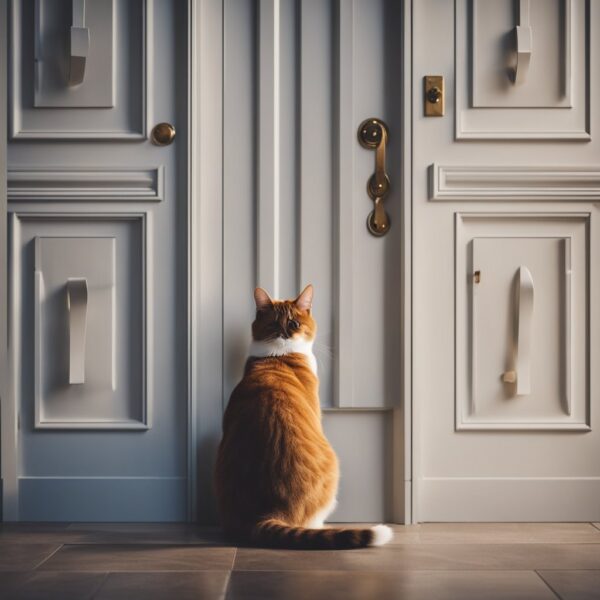
Cat Behavior Explained
Cats often display frustration when faced with closed doors in homes. This behavior stems from their natural instincts and unique personality traits. Cats hate closed doors because they limit access to territory, block curiosity, and prevent social interaction.
Felines are territorial creatures who view the entire house as their domain. A closed door stops them from patrolling and marking their space. It also blocks their view, which can make them feel unsafe or anxious. Cats are also very curious animals. They want to know what’s happening on the other side of that door.
Closed doors can affect a cat’s well-being by causing stress or anxiety. Some cats may scratch at doors or meow loudly to express their displeasure. Others might become withdrawn or show signs of depression when denied access to certain areas. Understanding why cats react this way can help cat parents create a more cat-friendly environment.
Key Takeaways
- Cats hate closed doors due to their territorial nature and curiosity
- Closed doors can cause stress and anxiety in cats
- Creating a cat-friendly environment can help reduce door-related issues
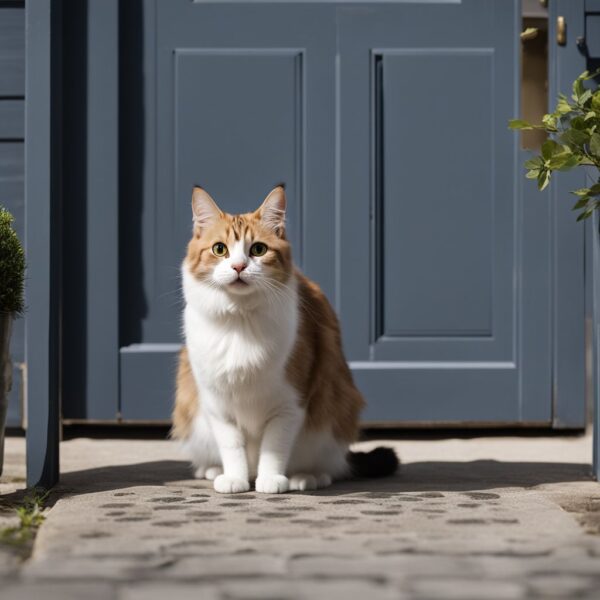
Understanding Cat Behavior and Territory
Cats are complex creatures with strong instincts that drive their behavior. Their need for control and independence shapes how they interact with their surroundings, including closed doors.
Territorial Instincts and Closed Doors
Cats see their home as their domain. They mark it with scent and patrol it regularly. Closed doors block their access to parts of their territory. This can make cats feel uneasy or frustrated.
Many cats will scratch or meow at closed doors. They want to check what’s on the other side. Some cats may even try to open doors themselves.
Giving cats free access to most areas helps them feel secure. Cat flaps or leaving some doors open can reduce door-related stress.
The Role of Curiosity in Feline Psychology
Cats are naturally curious animals. They like to explore and investigate new things. A closed door represents a mystery to be solved.
Cats may sit and stare at closed doors for long periods. They listen for sounds and sniff for scents. Some cats paw at door gaps to try and see inside.
This curiosity is linked to cats’ hunting instincts. In the wild, being aware of their surroundings keeps cats safe. At home, satisfying their curiosity through play and exploration keeps cats mentally stimulated and happy.
The Science Behind Aversion to Confinement
Cats have strong reactions to closed doors due to deep-rooted instincts and psychological needs. This aversion stems from their natural behaviors and survival traits.
Innate Fear of Being Trapped
Cats are born with a strong dislike of being confined. This fear comes from their wild ancestors who needed to stay alert and escape quickly from predators.
When a door is closed, cats may feel trapped and unsafe. They can’t see what’s on the other side, which makes them uneasy.
Cats rely on their senses to understand their surroundings. A closed door blocks their view and limits their ability to hear and smell. This lack of sensory input can cause stress and anxiety.
In the wild, being trapped often meant danger. This instinct is still present in house cats today, even when they’re safe at home.
Need for Control and Freedom
Cats are independent animals who like to make their own choices. They want to control their environment and movements.
A closed door takes away this control. It prevents cats from accessing areas they see as part of their territory.
Cats mark their space with scent glands on their paws and face. Closed doors stop them from refreshing these scent markers, which can be unsettling.
Freedom to roam is crucial for a cat’s mental health. When doors are closed, cats may feel their freedom is limited.
This need for control extends to social interactions. Cats like to choose when to be social or alone. Closed doors can interfere with this choice.
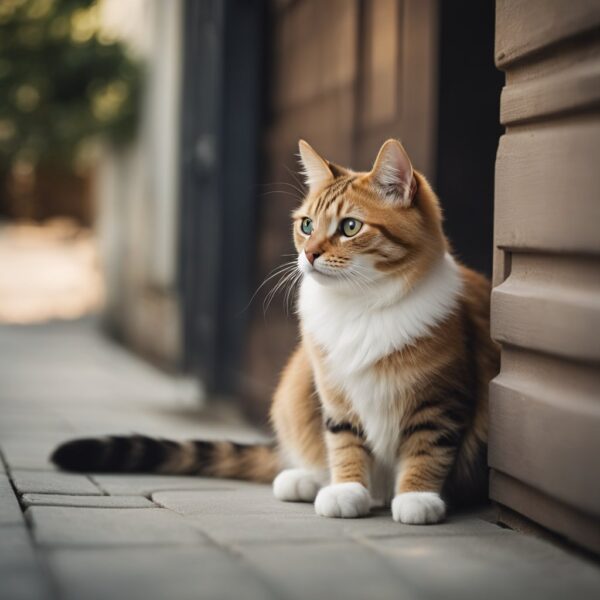
The Impact of Closed Doors on Cat Well-Being
Closed doors can upset cats and affect their well-being. Cats may show signs of distress when faced with barriers that limit their movement and access.
Distress Signals and Communication
Cats often meow or scratch at closed doors. These actions are ways they try to tell us they want the door open. Some cats may pace back and forth near the door.
Loud or repeated meows can mean a cat is upset. Scratching or pawing at the door is another sign of distress. These behaviors show that the cat is not happy with the closed door.
Cats may also sit and stare at the door for long periods. This can mean they are waiting for it to open. Some cats might try to open the door themselves by jumping at the handle.
Contributing Factors to Separation Anxiety
Closed doors can lead to separation anxiety in cats. This happens when cats can’t be near their humans or favorite spots in the home.
Signs of separation anxiety include:
- Excessive meowing
- Pacing
- Not eating
- Going to the bathroom outside the litter box
Cats that are very attached to their parents may have a harder time with closed doors. Kittens and older cats might also feel more anxious when separated.
Changes in routine can make separation anxiety worse. If a cat is used to having access to all rooms, suddenly closing doors can be upsetting.
Some cats may need extra attention or playtime to help with anxiety. Giving cats toys or treats when doors must be closed can help keep them calm.
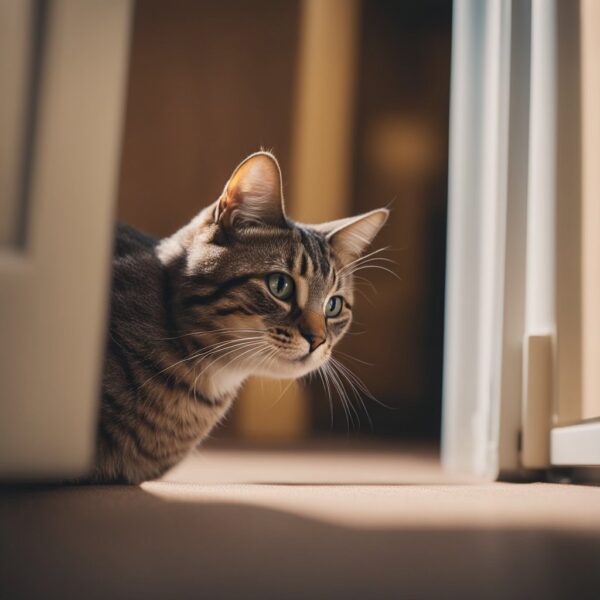
Interactive Elements and Behavioral Enrichment
Cats need mental and physical stimulation to stay happy. Providing toys, scratching posts, and social interaction can help reduce their focus on closed doors.
Toys, Scratchers, and Exploration
Cats love to play and explore. Puzzle toys filled with treats keep them busy. Feather wands let them “hunt” and pounce. Scratching posts give cats a place to stretch and mark their scent.
Climbing trees and perches satisfy their need to be up high. Boxes and paper bags make great hiding spots. Rotate toys to keep things fresh and exciting.
Cat grass or catnip plants add natural elements for cats to enjoy. Window perches let them watch birds and squirrels outside.
Social Interaction and The Need for Company
Cats crave attention from their guardians. Play with your cat for 10-15 minutes a few times each day. Use toys that mimic prey to tap into their hunting instincts.
Teach your cat tricks using treats as rewards. This builds your bond and gives mental stimulation. Brush your cat daily if they enjoy it.
Some cats like feline friends. A second cat can provide companionship when you’re away. Make sure to introduce new cats slowly and carefully.
If you work long hours, consider a pet sitter to visit midday. They can play with your cat and give fresh food and water.
Practical Solutions for Cat Parents
Cat parents can take steps to address their pets’ dislike of closed doors. These solutions focus on creating comfortable spaces and providing access options.
Creating a Sanctuary Space
Set up a cozy area for your cat with all the essentials. Put a soft bed or blanket in a quiet corner. Add a scratching post and some toys nearby. Make sure to include a litter box in an easy-to-reach spot.
Place food and water bowls in this space. Cats feel safe when they have access to their basic needs. This area can help reduce stress when doors are closed.
Try using calming pheromone sprays or diffusers in the sanctuary. These can help relax cats and make them feel more at ease.
The Use of Cat Doors and Door Buddies
Install a cat door to give your pet freedom to move between rooms. This allows them to explore without needing open doors. Cat doors come in various sizes and styles to fit different needs.
For those who can’t install cat doors, try a door buddy. This device keeps the door slightly open. It lets cats pass through but stops the door from closing fully.
Make sure any new door options are safe and secure. Introduce your cat to these slowly. Use treats to encourage them to use the new access points.
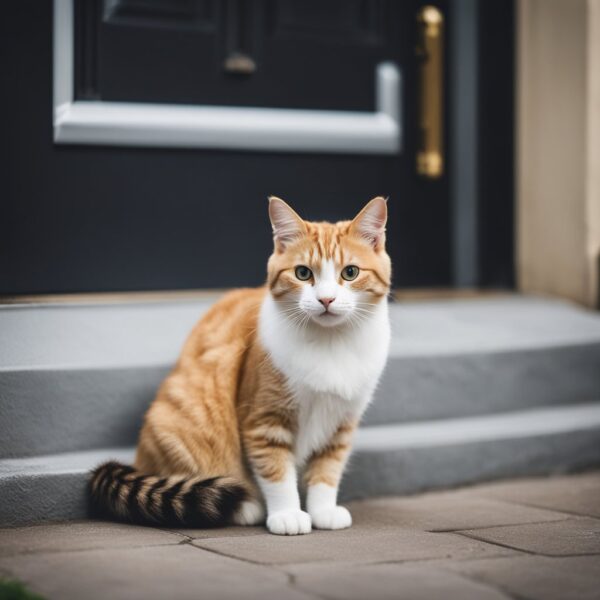
Frequently Asked Questions
Cats often display puzzling behaviors around closed doors. Their reactions can range from scratching and meowing to seemingly anxious or stressed responses. Understanding these behaviors can help cat parents better respond to their feline friends’ needs.
Why does my cat scratch the door when it’s closed?
Cats scratch closed doors to try to open them. They want to explore what’s on the other side. Scratching is also a way for cats to mark their territory with scent glands in their paws.
What causes a cat to meow persistently at a closed door at night?
Cats meow at closed doors at night for attention or to be let out. They may be hungry, bored, or simply want company. Some cats also have more energy at night and become more vocal.
Is it normal for cats to dislike closed doors within a home?
Yes, it’s normal for cats to dislike closed doors. Cats are curious and want access to all areas of their home. Closed doors can feel like a barrier to their freedom of movement.
Can keeping doors closed affect a cat’s mood or behavior?
Closed doors can make some cats feel anxious or frustrated. This may lead to changes in their mood or behavior. Cats might become more vocal, clingy, or even show signs of stress.
How should a Cat Parent respond to a cat that consistently tries to open doors?
Parents can provide alternate activities to distract their cat. Toys, scratching posts, or interactive play sessions can help. Some people install cat flaps to allow free movement while keeping doors closed.
Are cats more likely to become anxious or stressed due to closed doors?
Some cats may become anxious or stressed by closed doors. This is especially true if they’re separated from their humans or favorite spots. Not all cats react this way, but it’s important to watch for signs of distress.